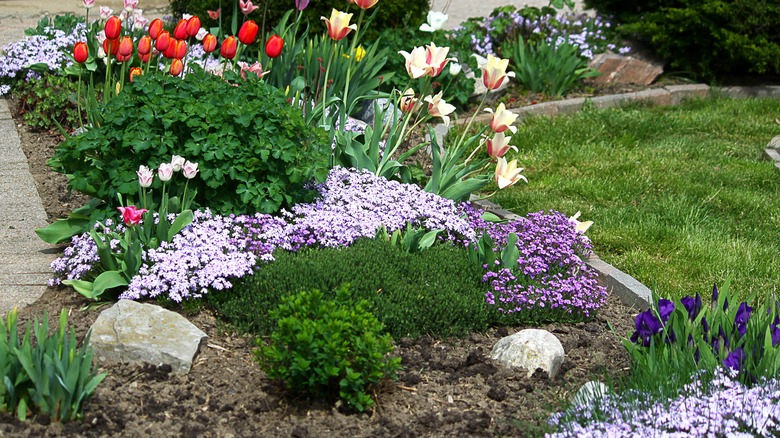There are few things more beautiful than spring bulbs. Daffodils, tulips, and hyacinths can provide a rainbow of colors as your garden slowly awakens. It sometimes seems like these fall-planted bulbs are the only flowers in the garden during early spring, but planting creeping phlox with your bulbs provides them with the perfect flowering companion.
You should plant bulbs for spring in the autumn in most zones, and some varieties require several weeks of temperatures below 45 degrees Fahrenheit to bloom well. Growers in warmer zones can either chill their tulips and hyacinths in a refrigerator or buy prechilled bulbs. Daffodils, conveniently, don’t require chilling. Use a fertilizer formulated for bulbs when planting them in autumn. As long as you plant fall bulbs in a space with at least 5 hours of sunlight and well-draining, mildly acidic soil with a pH between 6 and 7, they should provide a colorful display throughout the spring.
Creeping phlox is an ideal companion plant for bulbs

Creeping phlox (Phlox subulata), sometimes called moss phlox, is a native of the Eastern United States. An evergreen groundcover, it rarely grows over 6 inches in height but can spread to up to 3 feet in width and is covered in white, pink, or purple flowers in early to mid-spring. Its beautiful colors, unique mossy foliage, and early bloom time make creeping phlox a perfect complement to spring bulbs.
A creeping phlox plant requires similar growing conditions to most spring bulbs. It also grows best in well-draining soil with full sun and can grow well in acidic or neutral soil. Creeping phlox is hardy in zones 3 through 9, making it an ideal plant in almost all parts of the United States. It is also a hit with many pollinators, encouraging butterflies and bees to visit your garden early in the season before many other flowers have opened.
Creeping phlox provides year-round interest
Creeping phlox doesn’t just complement spring bulbs when everything is in bloom; it can also help to disguise the bulbs’ yellowing leaves after they finish blooming and begin dying back. While the dying foliage of bulbs may not be attractive, it’s important to avoid cutting it back if you want your bulbs to return the next year. Therefore, disguising the yellowing leaves with other plants is the best strategy. Creeping phlox’s lovely colors draw attention away from the spent tulips and daffodils.
Even after spring bulbs have entirely died back for the summer, creeping phlox still provides beauty with its moss-like evergreen foliage. While creeping phlox does not bloom as vigorously in the summer as it does in spring, it can sometimes produce another flush of blooms if it is trimmed back after flowering. Even when it is not in flower, creeping phlox’s foliage remains green year-round, making for a beautiful front-of-the-border companion to myriad summer, autumn, and winter plants, and providing charming low-growing interest in all seasons.